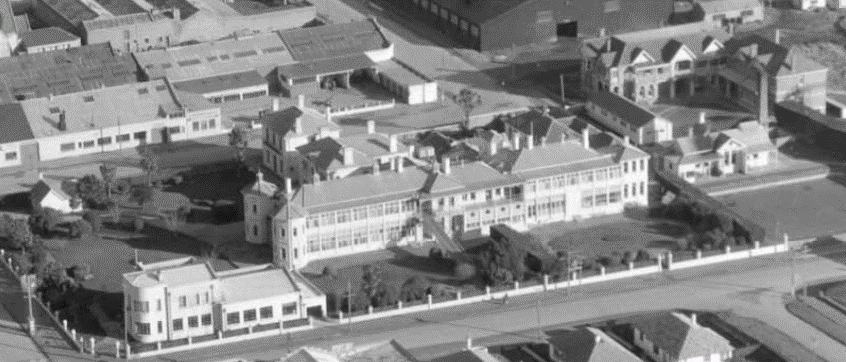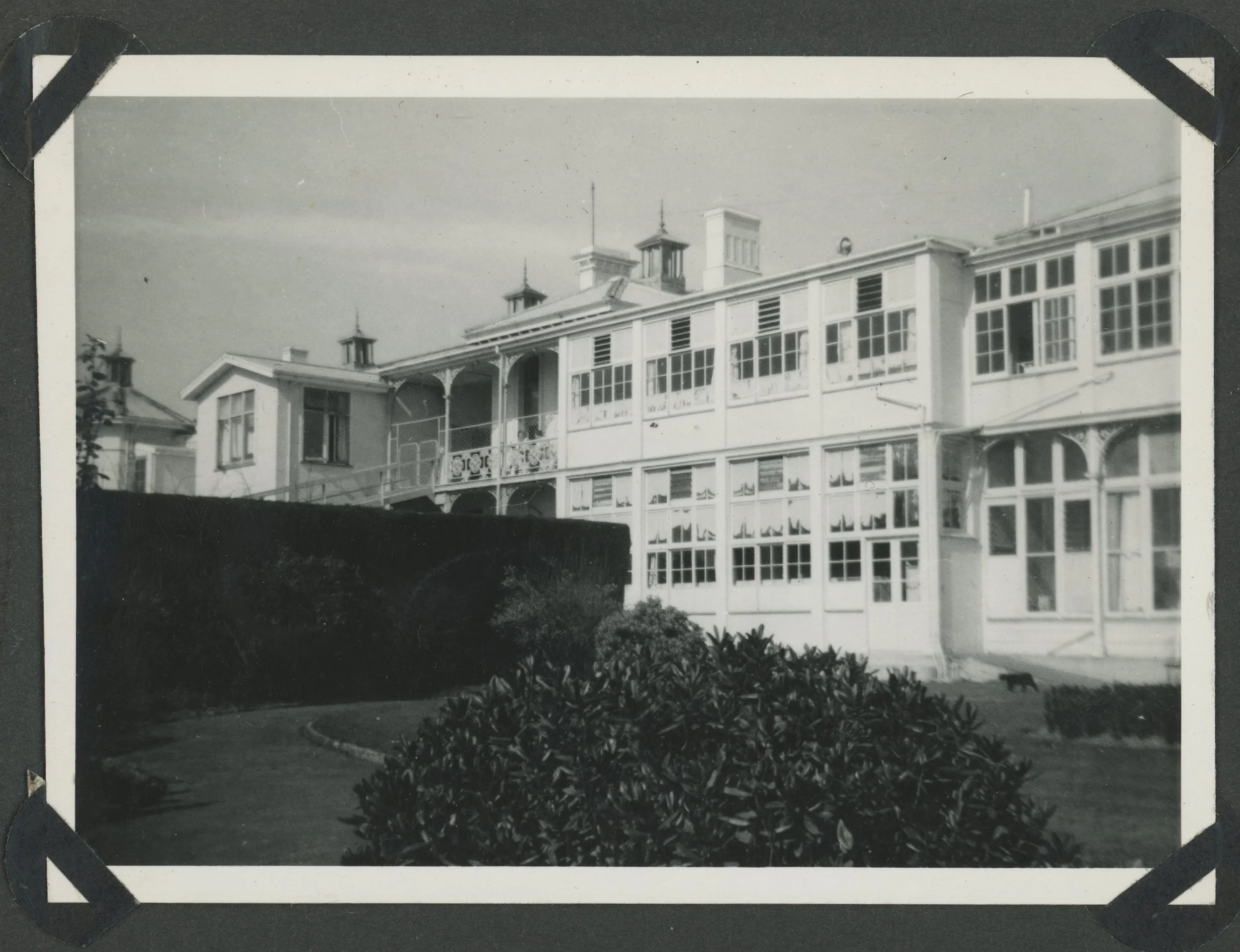
Image kindly shared by David Dudfield
Dee Street Hospital (Former)
Lot 5, DP 11873; Lot 1 and Pt Lot 2 DP 12591 (RT SL RTs SL9D/588, SL9D/587 SL8B/946)
Located at the northern end of the Invercargill CBD, Dee Street Hospital - later Queen Victoria Hospital and finally Invercargill Maternity Hospital -was established in 1863 and is recognised as New Zealand’s oldest public hospital building. Over time, its architecture expanded to include the North Wing (now lost), Central Block, South Wing, and Porter’s Lodge, each reflecting Victorian Classical design and the region’s growing healthcare needs. By the mid-20th century, it had become a dedicated maternity hospital, beloved by generations of Southlanders until its closure in 1979 when services moved to Kew Hospital. Now a Category 1 Historic Place, the site is being restored by the Troopers Memorial Corner Charitable Trust to honour its legacy and preserve the stories born within its walls.
Images kindly shared by David Dudfield
-
Block bounded by Gala Street, Dee Street, Leven Street and Victoria Avenue.
-
Architectural History
The hospital was built in stages over nearly 40 years:North Wing (1863) – later demolished for the Victoria Wing.
Central Block (1876) – architect F.W. Burwell. *
South Wing (1879) – originally accommodation for the House Surgeon, architect F.W. Burwell. Restored in 2000 and opened as residence for the Southland Art Foundation William Hodges Fellowship.*
Victoria Wing (1898) – commemorating Queen Victoria’s Diamond Jubilee
Porter’s Lodge (1866) – believed to be the oldest surviving house in Invercargill. *
*indicates building is still in existence
-
The Porter’s Lodge ~ Built around 1866, it’s believed to be the oldest surviving house in Invercargill. Originally, it served a practical role: housing the hospital porter, who was responsible for watching over the gate at the southeastern corner of the hospital complex. This small cottage was part of the hospital’s daily rhythm—welcoming patients, managing deliveries, and keeping order at the entrance.
Over time, as the Dee Street Hospital transitioned into a maternity facility and later closed in 1979, the Porter’s Lodge found new life. It was repurposed as the Citizen’s Advice Bureau for a number of years, continuing its legacy of service to the community. Today, it stands as one of three remaining hospital buildings (alongside the Central and South Wings), and is recognized as a Category 1 Historic Place, cherished not just for its architecture but for the stories it holds.
-
In 1905 it was decided to build a stand-alone Nurses Home. The plans showed ‘a handsome two storey building, containing nineteen bedrooms, a large sitting room and a large dining room with all conveniences.’ The estimated cost was £3,000.
Biographical / Historical
The Dee Street Hospital was constructed in sections over a period of nearly 40 years as a response to Invercargill’s growing population. Beginning with the North Wing in 1863, local architect F.W. Burwell added a Central Block in 1876, then in 1879 the South Wing, which was originally used as accommodation for a House Surgeon. All three Blocks were linked by corridors. The North Wing was later demolished to make way for a new section, named the Victoria Wing, in honour of Queen Victoria’s Diamond Jubilee. After the creation of the West Wing at Kew Hospital in 1957, Dee Street became solely a centre for maternity services, finally closing in 1979 with the introduction of Kew’s Obstetric Ward. Because of the architectural significance of the buildings, the Central and South blocks were placed under the New Zealand Historic Places Trust in 1984, then leased to the Southland Museum and Art Gallery Trust in 1988. In 1985, the Victoria Wing was demolished. The hospital blocks, particularly the central section, were designed in a Victorian Classical style and beautifully decorated internally and externally in plasterwork. The site also houses the hospital porter’s lodge, the original gates and masonry, and cast-iron fences.
Sources: Heritage New Zealand; A History of Hospitals and Healthcare: 1860s to the Present by Brent Coats, REF: LC 362.11 COA
History.
Invercargill City Council Archives, Dee Hospital, c.1890, A0105 ICCA
South Wing, Central Block and North Wing (now gone)

![Undated postcard [4], Dee Hospital, ICI58 ICCA.jpg](https://images.squarespace-cdn.com/content/v1/657f95322296ad309c34f084/1e3cdf99-7a17-4e8a-b8af-54b1037b5b96/Undated+postcard+%5B4%5D%2C+Dee+Hospital%2C+ICI58+ICCA.jpg)


Over the years, postcards have captured the evolving face of Dee Street Hospital—its architecture, its atmosphere, and its quiet resilience. Whenever an image resurfaces on social media, Southlanders respond with warmth, sharing memories of births, long shifts, and life within its walls. Stories flow of cold bathrooms, uneven floors, and beds that slid across the balcony-turned-ward. The ceilings were high, the routines strict, and the experience unforgettable. Dee Street wasn’t just a hospital—it was a rite of passage.
After the West Wing opened at Kew Hospital in 1957, Dee Street became a dedicated maternity unit, serving generations of families until its closure in 1979. That final chapter was marked not just by the filmed transfer of mothers and babies to Kew’s new obstetric ward—captured by DNTV2—but also through celebration. As recorded in the Southland Oral History Project, nurse Tui McIntyre reflected on her five-decade career and the garden party held to honour the approximately 250 maternity nurses who had trained at Dee Street since the first intake in 1952.
The Victoria Wing was demolished six years after its closure, making way for McDonald’s and its carpark. In 2000, the South Wing—now named Burwell House—was restored and used as a studio space for William Hodges Fellowship ‘artists in residence’ for a period of time.
Today, Burwell House, Porter’s Lodge, and the Central Block remain, along with the original fencing and gates. As Heritage New Zealand notes, they form “the only surviving collection of 19th century hospital buildings in the country.” These walls still speak—and Southland still listens.
Whites Aviation 1955 WA-39045
Taken from the north, this image shows the entire set of buildings, including the Nurses Home, far right.
Stories.
Nurses
Group of nurses outside the old hospital on Dee Street c.1900. Invercargill City Libraries and Archives, Ref: A0605 S27590002
The Southland Oral History Project has captured an assortment of heartfelt recollections from nurses who trained and worked at Dee Street Hospital, who share vivid stories of daily routines, camaraderie, and the lasting impact the hospital had on their lives and careers.
Before Maternity: Dee Street Hospitals’ First Chapter
Reflection from Oral History Interview of Elizabeth Michieson (Betty) SINCLAIR [Self Recorded Recollections of her Nursing Career 1934-1939], 2009
In 1934, at just nineteen years old, Betty began her nursing journey at Dee Street Hospital in Invercargill—a place that would shape her life over the next three years and three months. The hospital stood proudly along Dee Street, its three distinct blocks forming a hub of care and discipline. The main building housed five busy wards, while the central block contained offices and a laboratory. A third block accommodated domestic staff and second-year nurses, each space humming with routine and quiet purpose.
Betty and her fellow nurses lived nearby in a residence that went on to become the Salvation Army Hostel. Their days were tightly structured, commuting back and forth for shifts and meals, sharing facilities and adhering to the strict expectations. Uniforms spoke volumes: veiled matrons commanded respect, while probationers like Betty wore simpler attire and sat furthest from authority at mealtimes, the dining room itself a reflection of the hospital’s hierarchy.
Behind the main building, tucked away from view, stood the TB isolation house and sheds for infectious cases. Night duty there was a lonely affair—Betty recalled wringing linen in the dark, the silence broken only by distant footsteps or the rustle of sheets.
In 1937, the newly built Kew Hospital began to take over, and staff and patients gradually shifted across town. Yet Dee Street remained vital. When a fire broke out at Kew in 1939, patients were rushed back to Dee Street, which swiftly resumed its role as the region’s main hospital. During the war years, it became a place of healing for injured soldiers and a site for army medical exams, operating under blackout conditions and a sense of quiet urgency.
Nurses singing carols in hospital corridor c 1963-65. From the collection of the Southland Oral History Project, H0703 Dee Street Maternity Hospital Interviews, Diane Vincent-Collie, 2024
Balcony from the ‘old hospital’ ~ you could see the Takitimu’s on a good day’. From the collection of the Southland Oral History Project, H0703 Dee Street Maternity Hospital Interviews, Diane Vincent-Collie, 2024
The Maternity Years (1952–1979)
In November 2024, six maternity nurses who trained at Dee Street Hospital between 1958 and 1969 came together for a group interview as part of the Southland Oral History Project. Their conversation captured rich memories of life as trainee nurses — from living in the Nurses’ Home to the daily routines of a busy maternity ward during the post-war baby boom.
Each nurse began by sharing what inspired them to pursue nursing. At the time, the hospital was bustling, with 8–9 babies born per shift. Mothers were expected to stay in bed for the first 10 days after delivery, and often remained in hospital for up to 14 days. Without modern scans, twin births were often a surprise. The ward still operated under a strict, hierarchical system, likely influenced by English midwifery traditions. One memorable figure, Dr. Howell, would arrive in the early hours wearing a top hat, gloves, and carrying an umbrella — all of which a junior nurse would carefully take and hang on the latch.
Training was rigorous and structured. Nurses progressed through stages — prelim, junior, intermediate, and senior — with increasing responsibilities. After nine months, they were encouraged to begin delivering babies under supervision, though not for first-time mothers unless they showed confidence and skill. To qualify, each nurse had to deliver at least 20 babies and pass both hospital finals and a state exam at the end of their 18-month training.
Assignments rotated through the delivery suite, wards, nursery, and milk room, depending on seniority. Tutors like Sister Thompson and Sister Hamilton, and lecturers such as Mr. Insall, provided excellent education. Nurses wore their uniforms and caps to class, and respect for hierarchy was deeply ingrained — standing when doctors entered the room and deferring to senior staff.
Living in the Nurses’ Home was compulsory during training, and marriage meant leaving — though some returned later. The Home was a place where lifelong friendships were formed, and many fond memories were shared.
Audio clips on this page offers a vivid glimpse into life on the ward — take a moment to listen and step back in time.
Since the hospital’s closure in 1979, several reunions have taken place. The most recent, in 2024, saw over 40 former nurses visit the remaining Dee Street maternity buildings during International Nurses Day. These reunions continue to be filled with laughter, heartfelt stories, and cherished memories.
Doctor Remembered
Doctor Murray Lamb
With heartfelt thanks to Philippa Foes-Lamb, daughter of Dr Murray Lamb, for sharing these kind words and memories. Her tribute offers a glimpse into the compassion and dedication shown by the doctors who served at Dee Street Maternity Hospital.
Dad, Dr Murray Lamb, was a very well respected and much-loved GP in Invercargill for most of his medical career. He went the extra mile when it came to treating his patients and loved what he did.
Dee Street Maternity Hospital held a very special place in his heart. He felt it was such a privilege to bring new life into the world and the sparkle in his eye when he returned from Dee Street was proof of that.
Nothing held him back from delivering his patients’ babies, not even when he injured his foot badly, resulting in him leaving red footprints where he trod. He told his patient ‘I wouldn’t have missed delivering your baby for anything.’
Dad was a wonderful doctor with a truly lovely, caring soul.
Post war baby boom
Favourite time of year
A Glimpse into the Maternity Ward
Useful links

















